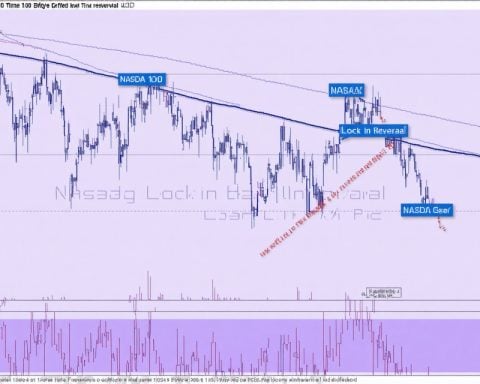- Dividend stocks are losing popularity in 2025 as the market shifts focus towards high-growth sectors like artificial intelligence.
- A reallocation of capital towards innovative sectors has left traditional dividend-yielding areas such as utilities and REITs less appealing.
- The underperformance of dividend stocks, like Comcast with its 5.70% year-to-date decline, illustrates the sector’s current challenges.
- Despite current struggles, some undervalued dividend stocks present potential opportunities for yield-seeking investors.
- Dividend stocks continue to offer stability and could benefit from a future rebound as part of well-balanced investment strategies.
In the swirling tides of 2025’s stock market, venerable dividend stocks find themselves grappling for stability, sidelined by a fervent focus on innovation and growth. Investors who once leaned on the rock-solid reliability of these stocks now witness a startling dip in allure as sectors like artificial intelligence steal the spotlight. Companies that were synonymous with steady returns are being outpaced, as the landscape shifts under the influence of high-growth prospects.
This year, the market has directed its capital with laser-like precision towards sectors ripe with explosive potential, such as the AI frontier, leaving traditional powerhouses like utilities and real estate investment trusts (REITs) somewhat adrift. This capital reallocation, fueled by the rise of breakthroughs like the pioneering DeepSeek AI from China, casts a long shadow over stalwart dividend-yielders. Even as they face this turbulence, the undervaluation of dividend stocks has led to intriguing opportunities for yield-seeking investors, turning neglected picks into hidden gems.
Among the struggling ranks, Comcast Corporation stands as a poignant example. With its stock price sliding 5.70% year-to-date, driven by a decline in its cable customer base and fierce OTT competition, Comcast exemplifies the pressures faced by dividend stocks. Yet, there are glimmers of resilience—revenues from its studio and connectivity sectors hint at a potential resurgence.
Amidst the flux of high interest rates and transformative tech dynamics, dividend stocks have not lost their essential value. They offer a beacon of stability, casting a reassuring light across investor portfolios. As the AI frenzy unfolds, the potential rebound of these dividend sector stalwarts could prove a rewarding chapter in the ongoing investment saga, urging prudent investors to consider the broader economic canvas before making their next strategic move.
Why Ignoring 2025’s Undervalued Dividend Stocks Could Be Your Biggest Mistake
How-To Steps & Life Hacks for Investing in Dividend Stocks Amidst AI Boom
1. Portfolio Diversification: Include a mix of traditional dividend stocks and high-growth sectors like AI. This mitigates risk while tapping into emerging market trends.
2. Focus on Quality: Choose companies with strong balance sheets, consistent dividend histories, and the potential for future growth, such as those branching into connectivity services like Comcast’s attempts.
3. Stay Informed: Keep abreast of market trends and technological advancements, ensuring your investments align with broader economic shifts. Signing up for finance newsletters or using stock analysis apps can be helpful.
4. Regular Reassessment: Review and rebalance your portfolio quarterly to accommodate shifts in market dynamics and sector performance.
Real-World Use Cases
– Income Generation: Retirees or those seeking regular income can benefit significantly from dividend stocks, as these often provide stable payouts even in volatile markets.
– Long-Term Growth: Investors using dividend reinvestment plans (DRIPs) can compound their returns over time, an effective strategy when share prices are undervalued.
Market Forecasts & Industry Trends
According to a report by Deloitte, technology sectors, especially AI, are expected to grow by 20% annually through 2030. However, as these sectors mature, dividend-paying companies, particularly those investing in tech advancements, may regain favor for offering stable returns.
Reviews & Comparisons
– Comcast vs. AI Pioneers: While Comcast is hindered by traditional cable declines, its investment in connectivity and tech adaptation could offer dual benefits. Comparatively, AI stocks like NVIDIA may offer higher growth but pose more significant risk due to market volatility.
Controversies & Limitations
Critics argue that dividend stocks can underperform in high-growth periods like AI’s rise. Furthermore, companies over-distributing dividends might limit their growth potential, reducing funds allocated for industry innovation.
Features, Specs & Pricing
– Comcast Corporation: Despite a 5.7% price drop, Comcast boasts a consistent dividend yield of around 2-3%, making it appealing to certain conservative portfolios.
– DeepSeek AI: As an innovative company from China, it highlights the transformative potential within AI, yet its valuations may be speculative without proven revenue stability.
Security & Sustainability
Dividend stocks often belong to established businesses with secure cash flows. However, in the face of innovation, their sustainability hinges on adapting business models to integrate AI and tech advances.
Insights & Predictions
The ongoing AI surge will likely create short-term volatility but may stabilize, allowing dividend stocks to reclaim prominence as reliable income generators, especially within sectors like studio entertainment and tech-driven utilities.
Pros & Cons Overview
Pros:
– Long-term security amidst market fluctuations.
– Regular income through dividends.
Cons:
– Limited capital appreciation potential.
– Possible underperformance against high-growth sectors like AI.
Actionable Recommendations
– Balance Your Portfolio: Consider allocating at least 30% to dividend stocks to hedge against tech volatility.
– Explore Growth Potential: Invest in undervalued dividend stocks with tech ambitions for combined growth and stability.
– Leverage Tech Tools: Use stock monitoring apps to stay updated on price movements and news.
For further information on investing strategies and market trends, visit Fidelity, a reliable resource for financial insights and advice.






















